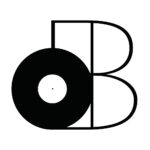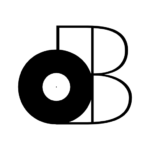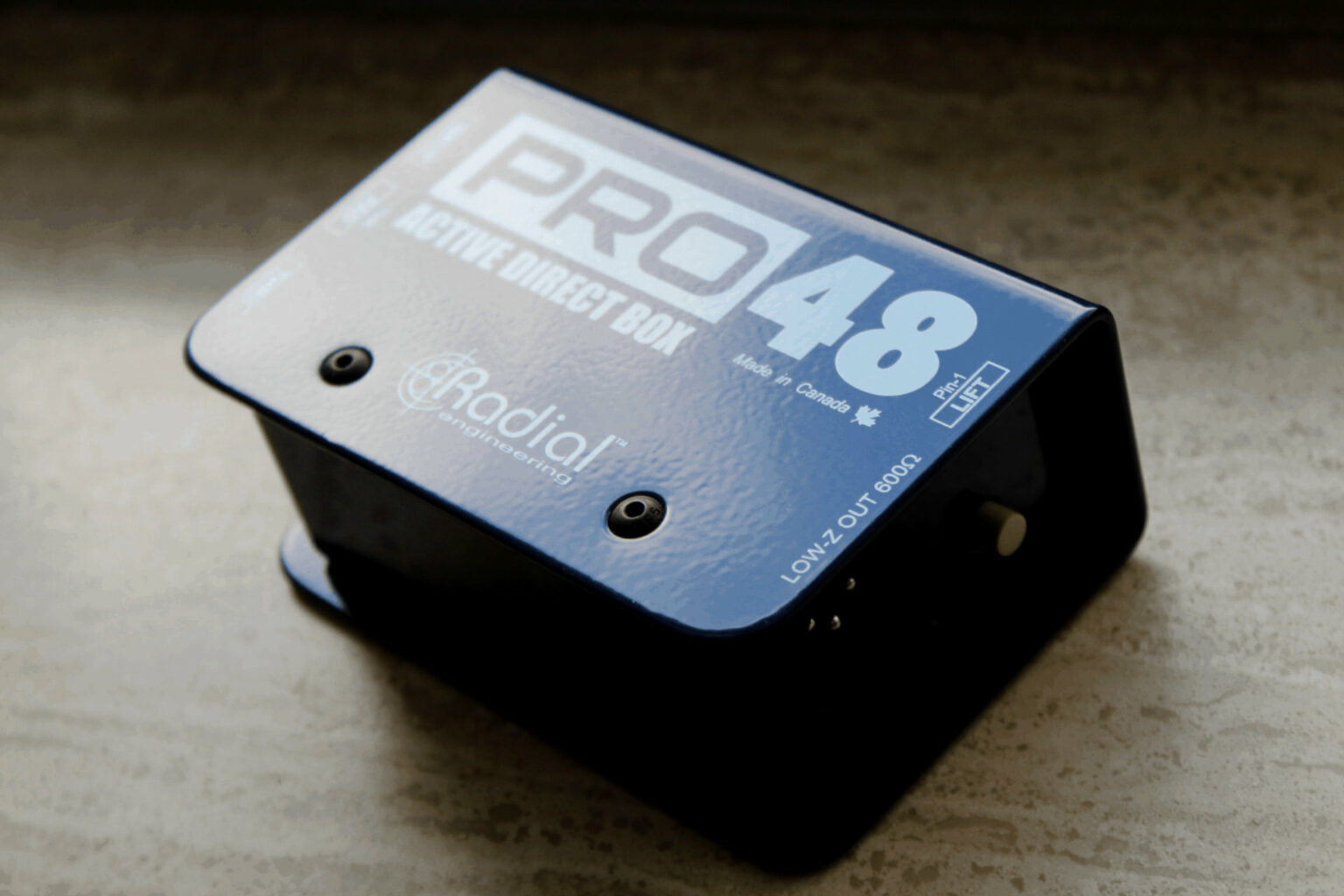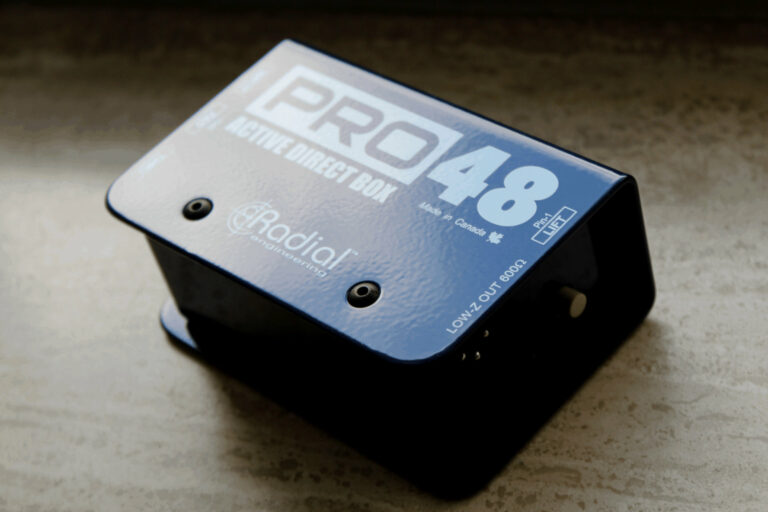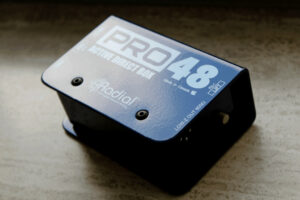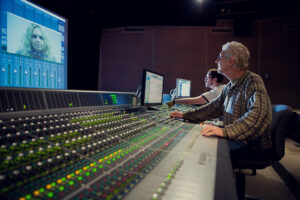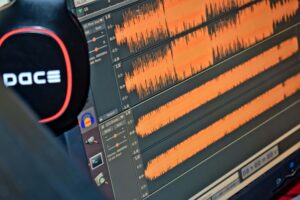The best budget DI boxes for bass and guitar are made by Radial Engineering.
To be more specific, we’ll be looking at the Radial Pro48 and Radial ProDI. The first is active and the latter is passive, so which one is the one for you?
We’ll be discussing the differences between active and passive DI boxes as well as comparing these two DI boxes side-by-side so you know which one to buy by the end of this article.
Here’s an overview of what we’ll be covering today…
- Active vs Passive DI Boxes
- Radial Pro48 Active Direct Box
- Radial ProDI Passive Direct Box
- Radial Pro48 vs Radial ProDI
- Summary: 2 of the Best Budget DI Boxes
Active vs Passive DI Boxes
The first question you should be asking yourself when it comes to DI boxes is…
Active or Passive?
One of the ways you can think about this is… If you’re using an instrument with active electronics, it goes into a passive DI box. If you’re using an instrument with passive electronics, it goes into a passive DI box.
However, that’s not necessarily the case anymore.
I personally use an active DI box with all my electric guitars and bass guitars.
Even the ones that have active pickups/electronics.
So, what difference does it make?
Regardless of whether you’re using active/passive electronics, basses and guitars are considered HIGH-IMPEDANCE instruments which is why you need a DI box in the first place.
That being said, the main difference between active and passive DI boxes is TRANSPARENCY.
Active DI boxes (like the Radial Pro48) are completely transparent.
Passive DI boxes (like the Radial ProDI) aren’t transparent and colour your sound.
When it comes to passive DI boxes though, that colouration can be pleasant or unpleasant. That’s why it’s sometimes easier to go with an active DI box (they all pretty much sound the same).
When shopping for passive DI boxes, you’ll simply need to know what you’re looking for.
The secret to an awesome passive DI box lies in its transformer.
Cheaper passive DI boxes usually have poor-sounding transformers.
However, the Radial DI boxes all sound great regardless of your budget!
Radial Pro48 Active Direct Box
Let’s start with the Radial Pro48 Active Direct Box because it’s what I use.
Here’s what it’s got to offer:
- I/O: 1x ¼” in/1x XLR out/1x ¼” through
- Attenuation: -15 dB Pad
- Ground-Lift: Yes
- Dynamic Range: 99 dB
- Frequency Response: 20 Hz – 20 kHz
- Maximum Input: 9 dB
- Warranty: 3 Years
So, it’s pretty simple… You plug your bass/guitar using the ¼” input, it gets balanced and converted to XLR. The throughput is great if you want to split your signal and/or send it to another preamp/amplifier.
That’s great for having TWO versions of the same signal (that’s how I do things).
The -15 dB pad really comes in handy when you’re plugging both active/passive instruments into the Radial Pro48. I usually use it when I connect my active basses/guitars.
That being said, the Radial Pro48 DOES work with active instruments, but you just need to make sure that the instrument doesn’t produce more than 9 dB of gain.
In an ideal world though, passive DI boxes are better for active instruments.
You’ll also need to keep in mind that active DI boxes such as the Radial Pro48 require 48V Phantom Power to operate.
Just make sure to verify that your audio interface/preamp can provide this.
Other than that, one of the most important drawbacks to note about active DI boxes is the reduced dynamic range.
The Radial Pro48 only provides 99 dB of headroom.
That’s more than enough for electric bass/guitar, but maybe not for acoustic.
Personally, it doesn’t bother me because you’ll end up compressing your signal in post-production EITHER WAY.
Active DI boxes sound more “compressed” and that could be a good thing.
If you don’t like that though, maybe the Radial Pro48 isn’t for you…
Radial ProDI Passive Direct Box
Now, we’re moving on to the Radial Pro DI Passive Direct Box.
Here’s what we got under the hood:
- I/O: 1x ¼” in/1x XLR out/1x ¼” through
- Attenuation: -15 dB Pad
- Ground-Lift: Yes
- Dynamic Range: 128 dB
- Frequency Response: 20 Hz – 18.5 kHz
- Maximum Input: 18 dB
- Warranty: 3 Years
You’ll immediately notice the improved dynamic range at 128 dB.
The Radial ProDI can also handle signals up to 18 dB, so your active instruments will most definitely make the cut!
Another advantage with the Radial ProDI is that it doesn’t require Phantom Power.
Instead, you’ll be relying on the performance of the Eclipse ET-DB2 transformer.
It sounds great, but it hasn’t built up the same reputation as the Jensen transformers found in higher-end DI boxes such as the Radial JDI.
If you’re new to DI boxes in general, the Radial ProDI will be more than suitable.
However, the world of passive DI boxes is MUCH larger than that of the active variety.
Each passive DI box has its own sound, so you might eventually start collecting them.
If that’s something that interests you, than maybe the Radial ProDI is the perfect starting point!
Radial Pro48 vs Radial ProDI
If you’re still hesitating between the two, here’s a table that clearly illustrates the differences between the Radial Pro48 and Radio ProDI…
| Radial Pro48 | Radial ProDI | |
| Inputs/Outputs | 1x 1/4″ in/1x XLR out/1x 1/4″ through | 1x 1/4″ in/1x XLR out/1x 1/4″ through |
| Attenuation | -15 dB Pad | -15 dB Pad |
| Ground-Lift | Yes | Yes |
| Dynamic Range | 99 dB | 133 dB |
| Frequency Response | 20 Hz – 20 kHz | 20 Hz – 18.5 kHz |
| Maximum Input | 9 dB | 18 dB |
| Warranty | 3 Years | 3 years |
As we discussed earlier, one of the main differences between these two DI boxes is the dynamic range.
The Radial Pro48 will give you more of a compressed sound.
The Radial ProDI will give you more of an open sound.
Another important difference to note is the reduced frequency response of the Radial ProDI. It will sound slightly darker, but since we’re using it for bass/guitar it really won’t matter.
You’ll most likely end up filtering out some high-end in post-production anyway.
Other than that, it’s really just a question of tone and of utility.
If you’re using mostly active instruments, you may want to lean towards the Radial ProDI.
If you’ve got mostly passive instruments, then the Radial Pro48 is the best option.
Summary: 2 of the Best Budget DI Boxes
In an even more ideal world… You should think about having BOTH of these DI boxes.
The Radial Pro48 and the Radial ProDI both have their strengths and weaknesses, so having the right tool for the job can make all the difference.
If you were going to choose only ONE of these though, I’d go with the Pro48.
In general, I’d always start off with an active DI box.
You may think that the reduced dynamic range makes a difference, but it really doesn’t in the case of electric bass/guitar. It may actually help!
Just think of it as an essential “preliminary” compressor.
The real advantage of active DI boxes lies in their transparency and because of that, their consistency. I also didn’t mention that active DI boxes are less noisy.
It’s not always the case, but a cheap active DI is guaranteed to perform better than a cheap passive DI.
So, which of these two DI boxes are you leaning towards? Do you feel like there’s another pair of DI boxes that should’ve made this list?
Share your thoughts in the comment sections and feel free to ask me questions as well!
Thanks for reading, now let’s get back to making music! Until next time.
Radial Pro48 Active Direct Box:
Radial ProDI Active Direct Box:
Sources:
